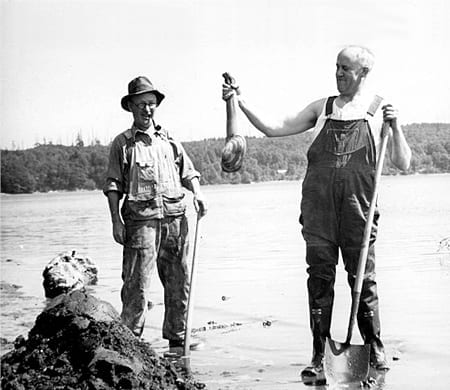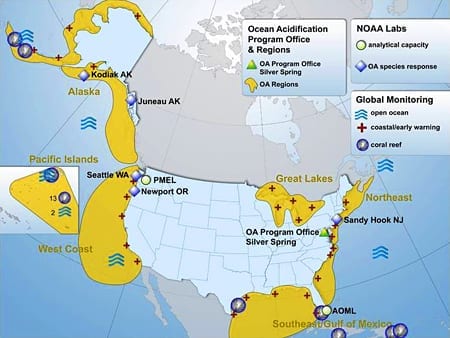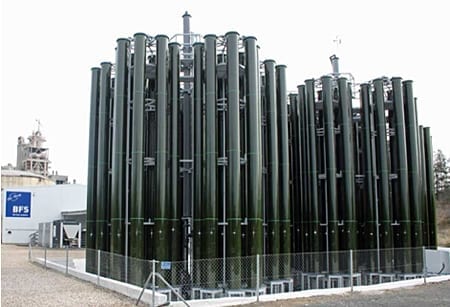By Daniel de la Calle•
Don’t be afraid to scratch if they itch:
•Anyone who has been to the Pacific Northeast in general and to Puget Sound in particular can bear witness to its beauty and uniqueness. An invisible contributor to this distinctiveness lies in the origin of its waters: strong currents bring cold ocean bottom waters up to the coast and consequently make them some of the most “corrosive” around the globe. Scientists studying this phenomenon last year determined that while the average global pH in the oceans is 8.1, in the Pacific coast the figure drops to 7.7; on some places in Hood Canal it even reaches 7.4. This obviously poses interesting questions about the future of its creatures: will it make them better prepared for lower pH levels? Or will the opposite happen? Are they already in such a precarious state that they could be the first ones to go?
Paul McElhany, research ecologist at the National Marine Fisheries Service in Seattle, confirms what we have heard so many times: “The ocean-chemistry changes we’re seeing are happening faster than we’ve ever seen in history. They can really alter the ecology of the ocean and lead to fundamental shifts in the structure of the marine food web.” These scientists are currently testing various levels of acidity on different marine organisms, like geoduck clams (the largest biomass in Puget Sound), but the next crucial stage will be to study genetic changes with University of
Washington experts and to build a miniature replica of the marine
environment with a San Juan Island laboratory to see what happens to the
food web when multiple changes take place simultaneously.

A mighty endeavor, since the network of interdependency between organisms is extremely intricate and tends to shift in a natural manner. Plus, we do
not know how a cocktail of Ocean Acidification, pollutants and higher
water temperatures will transform things either. To exemplify this complexity,
computer models at Seattle’s Northwest Fisheries Science Center predict
a decrease in herring population if Ocean Acidification was to reduce one
type of plankton eaten by these fish, but if Acidification were to have a larger effect on another type of plankton the number of herring could actually come up.
(A Documentary on Geoduck Clams)
•NOAA has selected Dr. Elizabeth Jewett as its first first director for the new Ocean Acidification Program. Established by Congress in 2009, the Ocean Acidification Program will plan and oversee a long-term coastal and open ocean monitoring program, lead research on the impacts of ocean acidification on marine ecosystems and the socioeconomic implications of these impacts. It will also provide educational opportunities to learn about this threat through national public outreach and coordinate activities with other agencies, nongovernmental groups and the international community.
Elizabeth Jewett will coordinate the ocean acidification work of 70 scientists from across NOAA, as well as extramural efforts led by NOAA’s academic partners. She will also represent NOAA on the interagency working group of the Subcommittee on Ocean Science and Technology of the National Science and Technology Council, coordinating federal activities on ocean acidification to better understand and address how a more acidic ocean will affect life on the planet.

“I’m thrilled to have the opportunity to be the first to lead and
coordinate NOAA’s dynamic ocean acidification research and monitoring
work,” Jewett said. “We now need to expand NOAA’s capacity and efforts
to better understand and respond to this very serious threat to the
world’s ocean, estuaries and Great Lakes.”
(Source and Credit: NOAA)
•The United Kingdom is developing along its coasts a network of Marine Protected Areas and Reference Areas.
While the first will only stop the most damaging activities, still
allowing commercial and recreational fishing, the much smaller in size
Reference Areas will play a key role in the success of the whole program.
These Reference Area waters will be completely protected and will allow marine life inside them a
return to an almost natural state. A study on various European reserves showed an average of over 2 1/2 times more marine life within such waters after a short period of time. Reference Areas eventually spill out fish
population into the surrounding sea and have the added benefit of being
more resilient to environmental threats like pollution, warming and
Ocean Acidification.
•We can unfortunately include another negative consequence of the increased CO2 levels in the atmosphere. Studies in the Proceedings of the National Academy of Sciences have discovered that higher atmospheric CO2 over the past 150 years has reduced plant’s stomata by 34%. Stomata are the spores in charge of transpiration: taking oxygen and carbon dioxide in and releasing water vapor.
“The increase in carbon dioxide by about 100 parts per million has had a profound effect on the number of stomata and, to a lesser extent, the size of the stomata,” confirms David Dilcher of Indiana University Bloomington. “Our analysis of that structural change shows there’s been a huge reduction in the release of water to the atmosphere. The carbon cycle is important, but so is the water cycle. If transpiration decreases, there may be more moisture in the ground at first, but if there’s less rainfall that may mean there’s less moisture in ground eventually.” Keep this crucial factor in mind: water vapor released from plants makes up 10% of humidity in the atmosphere. 
Photo by E. Lamertsma
•Spanish and French researchers have begun making bio-oil from captured CO2 and algae. The project, developed by a company called Bio Fuel Systems over the past five years, is trying to combine CO2 captured from a nearby cement factory in the city of Alicante (transported through a pipeline to the Bio Fuel Systems facility), where it is combined in 26 foot tubes (400 of them, see below) with millions of microscopic algae to replicate in an ultra accelerated speed the natural millions-of-years-long process of fossil fuel production.

It is currently in an experimental phase, but engineers believe that in ten years time, a possible unit covering 50 square kilometers in the barren regions of Southern Spain would produce 1.25 million barrels per day. They promote the system as “ecological oil”, a de-pollutant, since the process absorbs CO2 that would otherwise be released into the atmosphere.
Companies, especially several in the aviation sector, have shown interest in this bio-fuel as a replacement for classic oil and kerosene.
••••••••••••••••••



